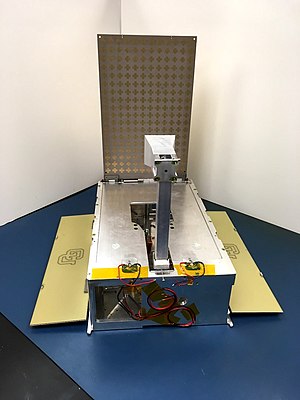 Prototype of CU-E3 nanosatellite | |
| Names | CU-E3 |
|---|---|
| Mission type | Technology demonstration |
| Operator | University of Colorado Boulder |
| Mission duration | 1 year (planned) |
| Spacecraft properties | |
| Spacecraft | Earth Escape Explorer |
| Spacecraft type | 6U CubeSat |
| Bus | XB1 (Blue Canyon Technologies - BCT) |
| Manufacturer | University of Colorado Boulder |
| Launch mass | 14 kg (31 lb) |
| Dimensions | 10 cm × 20 cm × 30 cm |
| Start of mission | |
| Launch date | NET 2024 (planned)[1] |
| Orbital parameters | |
| Reference system | Heliocentric orbit |
| Flyby of Moon | |
| Transponders | |
| Band | Uplink: C-band Downlink: X-band |
| Frequency | C-band: 5182 MHz X-band: 8447.6 MHz [2] |
| Capacity | 13 bit/s (at 27 million km) [2] |
| EIRP | 108 dBm [2] |
NASA CubeQuest Challenge | |
Earth Escape Explorer (CU-E3) is a nanosatellite of the 6U CubeSat format that will demonstrate long-distance communications while in heliocentric orbit.[3]
The Earth Escape Explorer spacecraft is a student-driven effort at University of Colorado Boulder to design and build the spacecraft as part of the NASA CubeQuest Challenge. It was planned to be one of thirteen CubeSats carried with the Artemis 1 mission into a heliocentric orbit in cislunar space on the maiden flight of the Space Launch System (SLS) and the Orion spacecraft, scheduled to launch in 2022.[4] Delays caused the spacecraft to miss its integration window to be included on Artemis 1; a new launch provider has not yet been chosen.[1]
- ^ a b Ohana, Lavie (3 October 2021). "Four Artemis I CubeSats miss their ride". Space Scout. Retrieved 6 October 2021.
- ^ a b c John S. Sobtzak; Elie G. Tianang; Varun Joshi; Breana M. Branham; Neeti P. Sonth; Michael DeLuca; Travis Moyer; Kyle Wislinsky; Scott E. Palo (2017). "A Deep Space Radio Communications Link for Cubesats: The CU-E3 Communication Subsystem". University of Colorado Boulder. Retrieved 10 March 2021.
- ^ "CU Earth Escape Explorer". University of Colorado Boulder. 2019. Retrieved 10 March 2021.
- ^ Anderson, Gina; Porter, Molly (8 June 2017). "Three DIY CubeSats Score Rides on NASA's First Flight of Orion, Space Launch System". NASA. Retrieved 10 March 2021.
 This article incorporates text from this source, which is in the public domain.
This article incorporates text from this source, which is in the public domain.